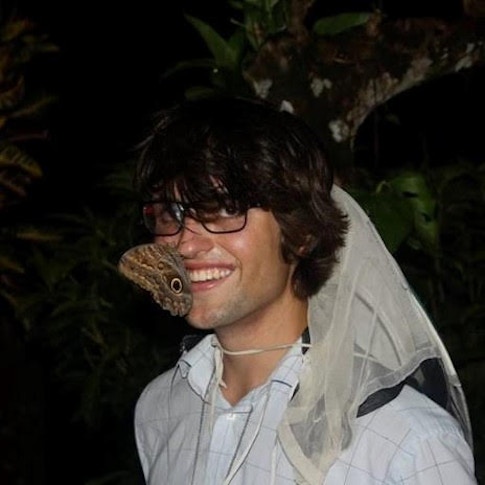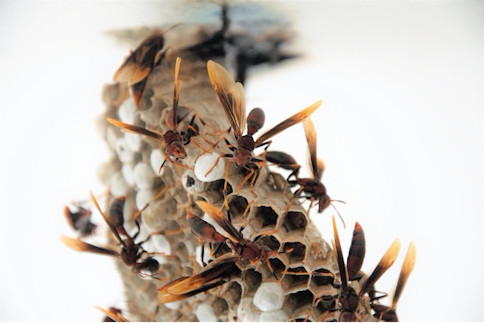Beyond the Sting: Why You Should Start Paying Attention to Wasps

For many of us, wasps — and those painful stings — are best avoided at all costs. But to behavioral ecologist Patrick Kennedy, wasps are fascinating creatures worthy of intensive study. In his work, he’s found that the social dynamics of wasps can yield clues about how cooperation evolves, as well as the power hierarchies that form and shift across the animal kingdom. It turns out that the “soap operas” that take place in wasp nests, as Kennedy affectionately describes them, are in fact highly meaningful.
Kennedy, who joins the Simons Society of Fellows in 2021, plans to conduct field studies of wasps in Cameroon and South Africa as soon as pandemic travel restrictions allow. He will conduct this work during a postdoctoral appointment in Dustin Rubenstein’s lab at Columbia University. Prior to joining the Simons Society of Fellows, Kennedy earned a bachelor’s degree in biology from the University of Oxford in 2013 and a doctorate in evolutionary biology from the University of Bristol in 2018. Kennedy and I recently discussed why everyone should be interested in wasps and what they can teach us about ourselves.
Our conversation has been edited for clarity.
What can we learn from studying wasps as opposed to, say, dolphins?
Nothing against dolphins, but here’s the thing: The social dynamics of wasps are amazing. Forget House of Cards or The Sopranos: Just look at what’s going on inside wasp colonies. You have families striving for survival, heroic self-sacrifices and even high-stakes battles for power. Like all animals, wasps are engaged in an eternal struggle to populate future generations with copies of their genes — through any means necessary. It’s like a 100-million-year-old soap opera. But what makes wasp behavior even more appealing to me is that it’s so easy to observe and learn from.
Your work is particularly focused on what are known as ‘primitively social’ wasps. What are those?
The term primitively social is a bit of a misnomer, because these wasps’ social lives are actually quite rich. We call them primitive because their social roles are less set in stone, unlike more famous social insects, such as ants, honeybees and yellow jacket wasps. Those insects are born with a body built for their particular role, and only specialist reproductives, that is, males and the hopeful queens, are capable of mating.
By contrast, all members of a primitively social wasp group are physically capable of mating and reproducing. This means that, in principle, any female can become the queen, though only one wasp will ascend to the throne in the end. Indeed, most of the primitively social wasps will forfeit their reproductive rights, choosing to make this personal sacrifice.
Why and how does this happen? And what influences their decisions? Those are some of the driving questions in my research.
From an evolutionary standpoint, the fact that honeybees, ants and the like have evolved such highly defined roles is mind-blowing. However, if we want to understand why some insect societies evolve into those in which everyone has such clearly defined roles, it makes a lot of sense to take a closer look at the ones that don’t: the primitively social species.
How do you go about studying wasps?
The first rule of thumb is not to alarm them. This means working slowly and quietly. If you move too quickly, they see you coming. Wasps often live in unusual places. I’ve tracked down colonies in an abandoned army bunker in the rainforest, under bridges in a mosquito-infested mangrove swamp and in the ruins of a Cold War submarine radar station!
To track their movement between nests, we give each wasp a tiny RFID tag that is about the size of a single grain of rice. We also manipulate colonies experimentally. Then we watch, sometimes for hours, recording interactions. Over time, it becomes easy to spot how individual wasps adopt their own social strategies. For example, some wasps spend their time hunting caterpillars to feed the young, while more power-hungry wasps stay at home, taking fewer risks in the hope of one day inheriting the position of queen. Each of these strategies is an effort to maximize the chance that the wasp will spread copies of its genes to future generations.
As part of my doctoral work in French Guiana, I studied more than 1,000 wasps, which was easily the largest number of wasps I studied at any one time. Despite this large number, each individual nest I study is typically quite small, housing just a few dozen wasps at most. This is another practical reason to look into the primitive wasps: I can see everything that’s going on. And because the nests are largely open-air, I can put my head right up next to it to make my observations.

Tell me more about your doctoral work.
Traditionally, experts have theorized that primitive wasps will only assist their very closest family members, those living within the same nest. But more recently, some have observed certain species of Latin American wasps helping more distant relatives who live further afield. We wanted to know why. For my doctoral research, I studied the wasp genus Polistes in Panama, Brazil and French Guiana. Through a combination of field experiments, colony monitoring and theoretical modeling of various hypotheses, we argued that the neighborly generosity of these wasps evolved because they can sometimes become redundant, or not needed, in their home nests. Switching colonies offers a way to be more helpful to the extended family.
That’s touching — even wasps need a sense of purpose. Looking toward the future, what do you plan to study during your Simons fellowship?
Once pandemic travel restrictions are lifted and I can resume fieldwork, I’ll be working with local collaborators in Cameroon and South Africa to test how the need to hibernate affects wasp social dynamics. One of Africa’s most common wasps, Belonogaster juncea, thrives across sub-Saharan Africa. In tropical climates near the equator like we see in Cameroon, hibernation isn’t necessary. But in more temperate climates further from the equator, like in South Africa, the wasps must hibernate during the four coldest months of the year. How does this difference affect the evolution of wasp social behavior? Is there evidence that cooperation between wasps is greater in one environment versus the other? That’s what I hope to find out.
These questions may sound niche. But insects like the wasps I study are “the little things that run the world.” Yet much of their variation in their social behavior remains unexplained. Several biologists have floated the idea that some of these mysteries could be resolved if we factor in variations in climate. My fellowship is one attempt to examine this notion in detail.
That leads to a final question. How can behavioral ecology research like yours help us understand humans?
All animals are dedicated to propagating their genes into future generations — whether by helping their kin or by getting ahead themselves. Often this involves forming hierarchies within animal groups. How do these social hierarchies form, how do they endure and how can they be disrupted? Every one of these questions matters to us.
On a different level, just think about the human body; it contains trillions of cells. Most cells help to build our bodily tissues and organs. Precious few cells are left for reproduction. This strict division of labor is, in a way, echoed by societies of advanced social insects, like honeybees, in which only the queen and her consorts mate and reproduce while large numbers of workers build and tend the nest and eventually die. We ourselves are the products of vast cooperation among cells (not to mention among the genes that comprise our genome), so understanding the fundamental evolutionary principles that tip the dial from conflict to cooperation is about as existential as it gets. And wasps have been workhorses for rigorously testing the predictions of these theories for decades; that in itself is a compelling reason to make them the focus of further study.